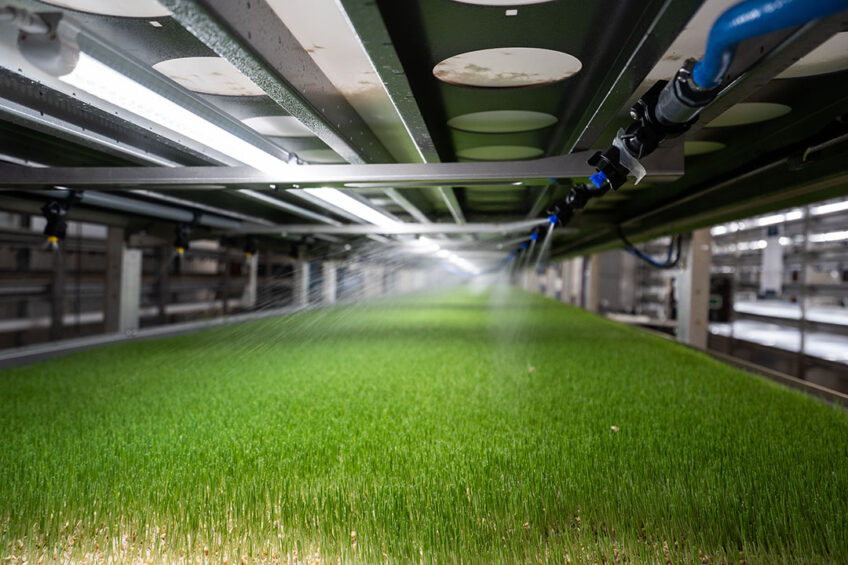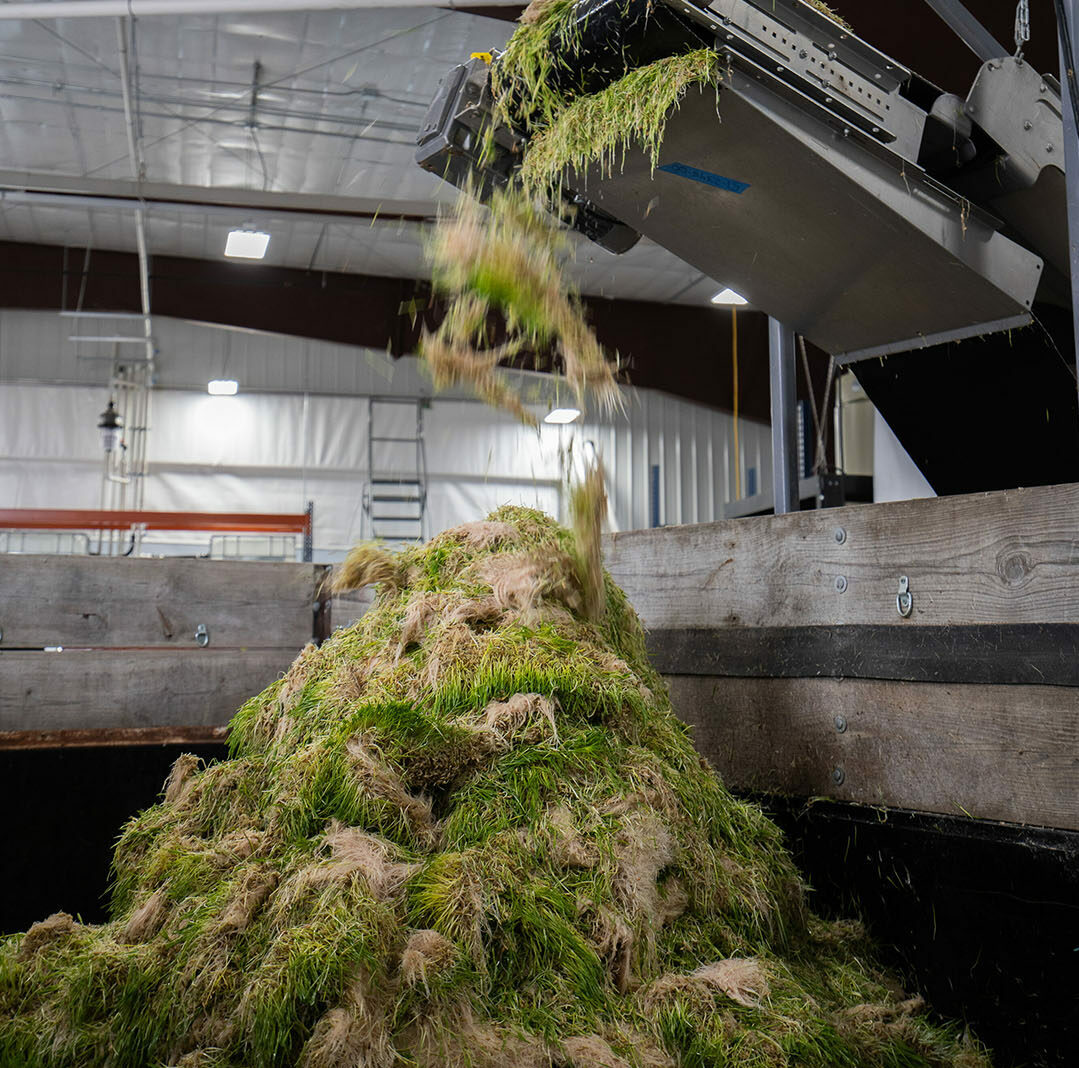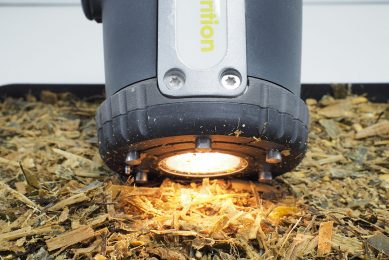Indoor grown wheat sprouts fill feed gap

With installations on farms in Italy, North America and Japan, HydroGreen provides a solution for several ranchers and dairy farmers. For them, this indoor grown forage provides more feed security when there is not enough feed coming from their land.
It’s been a year of severe drought across many parts of the USA and the Canadian Prairies. This has been particularly hard for beef ranchers, who rely on grassy marginal lands for feed.
Several years ago, when a US rancher named Dhil Grohs was operating in an area of Idaho with limited rainfall, he began developing a hydroponic indoor feed production system he could rely on to meet some of his cattle’s needs. He called it HydroGreen. With this system, wheat or barley seed is continually sprouted and harvested every 6 days.
Sprouted wheat
HydroGreen was acquired in 2019 by CubicFarm, a maker of indoor greenhouse food crop growing systems, founded in 2015 and based in Langley, British Columbia, Canada. HydroGreen is based in Sioux Falls, South Dakota, USA. The system is technologically advanced yet very simple in terms of cultivation, with automated seeding, watering and harvesting. No fertilizer is required.
Once ready for harvest, the sprouted wheat or barley rolls off an automated belt like a carpet and is shredded, ready to be added to the ration for dairy or beef cattle. The percentage of the ration that can be met with fresh HydroGreen feed is at least 15% for dairy and about 30% for beef. However, the sprouts are also suitable for other livestock categories such as poultry and goats.
A good option in tough circumstances
Particularly for independent beef ranchers today, HydroGreen provides a good option among a limited number of tough alternatives, explains HydroGreen president, Dan Schmidt. Feed sources are limited in North America and beyond, he notes, due to the increasing frequency of prolonged droughts. “Because [beef ranchers] don’t have enough feed coming from their land, they are being faced with having to sell their cattle and for some of them, it’s more serious,” Schmidt says. “They have to sell their farms, make a big investment in another type of livestock farming, or make a smaller investment and keep their beef cattle.”
Two systems
The HydroGreen DGS 66 unit is geared to operations of 100 to 200 cattle, beef or dairy. There are now 7 HydroGreen systems installed in the Western USA (beef), 4 in Canada (beef and dairy), 2 in Agropoli, Italy (a water buffalo dairy herd called Massaria Cielentana, about 100 km from Naples) and 1 in Japan (dairy). In the US Midwest, 12 more installations are in progress.
One HydroGreen unit costs US$ 139,000 (€ 124,000). It must be housed in an existing or newly-constructed building of at least 1,500 square feet (46sqm) and outfitted with appropriate plumbing and electrical infrastructure.
Vertical Pastures
Recently, to address the needs of larger cattle operations, HydroGreen have created Vertical Pastures, which is about to be piloted. As the name suggests, this is a vertical growing system, consisting of groupings of a larger module called the GLS 808. Each of these modules costs US$ 265,000 (€ 226,794) and provides part of the ration for about 170 cows.
Vertical Pastures is about to be piloted at Burnett’s Land & Livestock in Wyoming (installation expected to be complete by the end of 2021). The harvest will make up part of the ration for some of their dairy cattle. Burnett invested US$ 1.5 million in CubicFarms and is receiving 12 GLS 808 units as part of the deal. The cost of 12 modules is US$ 3.18 million (€ 2.72 million).

CubicFarm communications manager, Andrea Magee, explains that the building at Burnett, which will house the 12 modules, is about 1 acre and has room for expansion to 24 modules. The 12 modules being installed now will provide Burnett with up to 72,000 lbs (33 tonnes) of fresh feed daily (16 tonnes of dry matter). “As part of the ration,” Magee says, “that’s enough to feed 2,000 animals daily.” HydroGreen is collaborating with Burnett on research into the analysis of its feed and how it impacts cow health.
ROI factors
With these systems, ROI (not including the costs of a properly outfitted building) is dependent on ongoing operational costs for water (if any), electricity and grain seed, but also on costs for feed, feeding cattle (labour, fuel, etc.) and so on that existed prior to system use. Estimates of operational costs are not available from HydroGreen for any of its installations around the world. Existing feed costs can, of course, include transportation. Burnett’s in Wyoming, for example, have been transporting cottonseed from Texas for part of their dairy cattle ration.
ROI can also be affected by higher profits, for example, if certified organic grains are sprouted and the resulting beef or dairy products are certified organic and sold at a premium. Schmidt adds that a premium for beef can also potentially be achieved because the use of HydroGreen sprouts can result in higher meat quality in terms of taste and marbling. Faster finishing may also be possible. HydroGreen is currently quantifying health and meat quality using ‘indirect observation’ and reports from customers.
Nutritional analysis
Fernando Diaz, CEO and dairy cattle nutritionist at Dellait, was hired by HydroGreen to do an independent analysis. “HydroGreen sprouts are very high in energy content; they can replace energetic forages such as maize silage, and alfalfa and alfalfa/grass forages with high relative feed value,” he says. “HydroGreen sprouts can also replace other fibre-rich co-products such as cottonseed, maize gluten feed and soybean hulls. In addition, sugary co-products such as molasses and whey are not needed in HydroGreen diets.”
The protein content in HydroGreen sprouts is similar to that of high-quality grass pasture (15-20% dry matter basis). Sugar content is extremely high in HydroGreen (more than 30% dry matter) compared with grass pasture (less than 15% dry matter). Similarly, total digestible nutrient concentration is at least 10 percentage points greater in HG sprouts (>75% dry matter).
“Overall, including HydroGreen in dairy cow diets improves palatability, total dry matter intake and overall production performance. Another advantage of HydroGreen sprouts is their low potassium content, so they are an excellent forage for close-up (pre-partum) cows.”
At the time of publication, no details were available, however, about how much dry matter intake and cow performance were improved, how many cows were involved in the trials, or what was replaced in their diets by HydroGreen sprouts.









